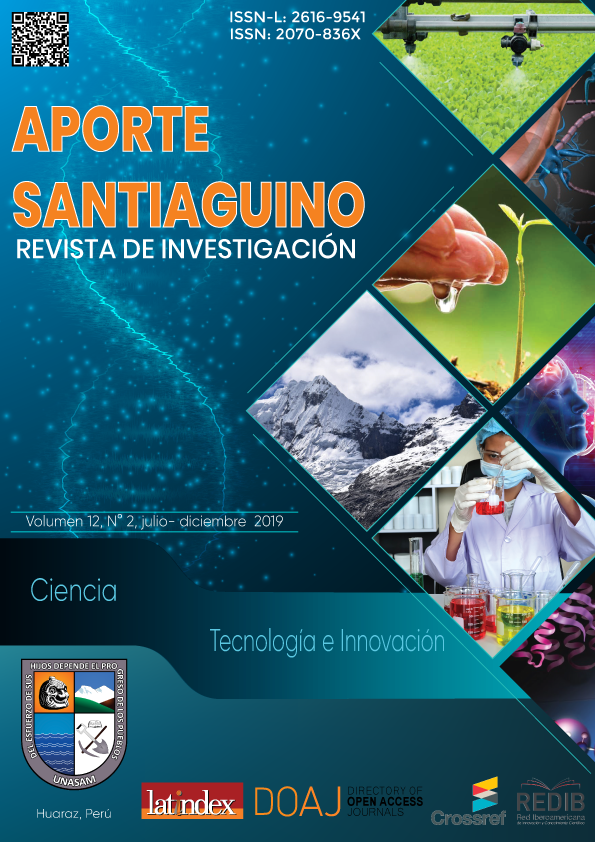Sustainable alternatives for crop residues management in avocado and tangerine agroecosystems in Cañete, Lima, Peru
DOI:
https://doi.org/10.32911/as.2019.v12.n2.644Keywords:
avocado, management, organic matter, recycling, tangerineAbstract
The objective of this studywas to identify the sustainable alternatives for crop residues management, implemented by avocado (Persea americana Mill.) and tangerine (Citrus spp.) producers in Cañete, Lima, Peru. For this, 48 farms, located in the districts of San Vicente, San Luis, Quilmaná, Nuevo Imperial, Imperial and Lunahuaná, were visited. The results indicated that, the sustainable alternatives for crop residues management consisted in threshing and incorporation into the soil after pruning, mulch, the urial of discarded fruit and the use of parasitoid recovery chambers
Downloads
References
Bahadur, I.; Sonkar, V. K.; Kumar, S.; Dixit, J. y Singh, A. P. 2015. «Crop residue management for improving soil quality & crop productivity in India». Indian Journal of Agriculture and Allied Sciences 1(1): 52 - 58.
Ciro, P.; Holguín, M. y Álvarez, L. 2014.Manual de Buenas Prácticas Agrícolas en cultivos de cítricos en el Suroeste antioqueño. CITRICAUCA, Antioquia, CO. 154 pp.
Cisneros, F. 1995. Control de Plagas Agrícolas. Segunda Edición. Capítulo 8: Control Biológico, p. 102 - 147. Full Print s.r.l., LaMolina, Lima-PE.
Collantes, R. y Rodríguez, A. 2015a. «Diversidad de avispas parasitoides (Hymenoptera) en agroecosistemas de palto (Persea americana Mill.) y mandarina (Citrus spp.) en Cañete, Lima, Perú». Aporte Santiaguino 8(2): 207 - 218.
Collantes, R. y Rodríguez, A. 2015b. «Sustentabilidad de agroecosistemas de palto (Persea americana Mill.) y mandarina (Citrus spp.) en Cañete, Lima-Perú».Tecnol.desarro 13(1): 27-34.
Collantes, R.; Rodríguez, A. y Canto, M. 2015. «Caracterización de fincas productoras de palto (Persea americana Mill.) y mandarina (Citrus spp.), en Cañete, Lima, Perú». Aporte Santiaguino 8(1): 33 - 44.
Collantes, R.; Perla, D.; Rodríguez, A.; Beyer, A. y Altamirano, J. 2016. Acacia horrida (L.) Willd.: Refugio de artrópodos benéficos en la costa peruana. Saber y Hacer 3(1): 37 - 47.
FAO (Organización de las Naciones Unidas para la Alimentación y la Agricultura, IT). 1997. Zonificación agro-ecológica: Guía general. Boletín de Suelos de la FAO 73, Roma. 98 pp.
Julca, A.; Rodríguez, P.;Meneses, L.; Blas, R.; Bello, S.; Anahul, J.; Crespo, R.; Castañeda, E.; Reynoso, A.; Schuller, S.; Fundes, G. y Santibañez, R. 2006. Selección de fuentes naturales para la fertilización de café en el marco de una agricultura orgánica. Línea base de Proyecto financiado por INCAGRO, en alianza con la UNALM, la FDA, la JNC y el INIEA. 53p.
León-Velarde, C. y Quiroz, R. 1994. Análisis de sistemas agropecuarios: uso de métodos biomatemáticos. CIRNMA- CONDESAN. Puno, Perú. 238 pp.
Obi, F.O.; Ugwuishiwu, B.O. yNwakaire, J. N. 2016. «Agriculturalwaste concept, generation, utilization and management». Nigerian Journal of Technology 35(4): 957 - 964.
Saravia-Matus, S. y Aguirre, P. 2019. Lo rural y el Desarrollo Sostenible en ALC. 2030-Alimentación, agricultura y desarrollo rural en ALC, No. 3. FAO, CL. 20 p.
SENASA (Servicio Nacional de Sanidad Agraria, PE). 2014. Todo sobre las moscas de la fruta. 22 pp.
Ureña, J. 2009.Manual de Buenas Prácticas Agrícolas en el Cultivo de Aguacate: Para miembros del Centro Agrícola Cantonal de Tarrazú. 52 pp.




















